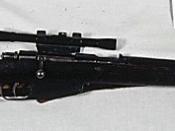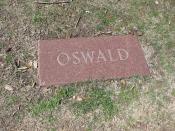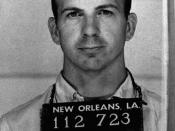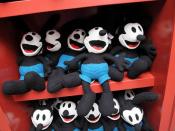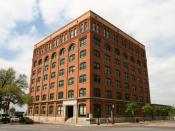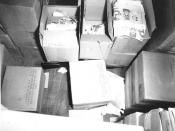In his tenth novel Libra, Don Delillo wrote an alternative history based on President Kennedy's assassination and on the implication of his presumed murderer Lee Harvey Oswald. All along the novel, Don Delillo dealt with the mystery of the image and its power over people. The language of photography, the iconographic evidences and the cinematic techniques often linked to the question of appearance instituted a conflict between the reality and which is not. It offered a different view of the events and the characters. Among the various concepts of image (photography, television and video), it would be judicious to study their suggestive quality such as their impact, their meaning and their expressiveness.
Photography and cinematic language were evoked in different ways. The chapters about Nicholas Branch presented photographs as evidences of the investigation. The retired analyst of the C.I.A did not know how to exploit these pictures because of their bad quality.
Indeed "many are overexposed, light-blasted, with a fade quality beyond their age" (p 182). Branch realized he had to study conscientiously each piece of evidences but did not understand the utility of a futile picture of "Curtain rods found on shelf in garage of Ruth Paine" (p182). All this documentation seemed to confuse him. They were strange. They were morbid and succeeded to disturb him. It is interesting to question here the power of photographs regarding the effect they had on the analyst. The pictures were a sharp instrument to confront the character with its own fascination. In other words, the discomfort of Branch could be due to his fascination for the truth. He wanted to know. He would like to resolve the case. Consequently he felt connected to the evidences which were the truer representations of the facts. Indeed the first level of a picture is to be the reality; nevertheless it was only the first level.
The picture could also present a fake reality. One of the best examples is the passage when Marina took pictures of Oswald in their court yard in Dallas. The reality was false in the sense that Oswald "posed in a corner of the yard, the rifle in his right hand, muzzle up, butt end pressing on his waist, just inches from the holstered.38". He made an impression of reality. Besides, reality must be a shoot taken from life, by surprise, without any preparation, with sincerity and authenticity. Oswald formed a reality in a specific purpose. Surely with such an argument, every photograph could be said fake but we have to understand the term "fake" as opposed to "real". Oswald created a character by taking this picture, a character he is persuaded to be. On the other hand, the reality can be altered by the instrument used, a telescopic sight for example. The telescopic sight permits to shot someone from a long distance. Although the result is not a photograph, this example can be used to illustrate the confusion between the reality and what the eyes see. The truth is that the snipers in Libra shot a series of image. Can you kill an image? The shooters did not shot people but their image, there is none accuracy in such an act. Everything is about impression and appearance of what is really happening a few meters away. It is not reality but the impression of it. Yet the visual information imposes upon a person without any ambiguity. Accordingly the telescopic sight gives a reflection of the reality, a distorted reality that the sniper believes to be the reality itself. Finally, this reflection totally replaced the reality itself as in the following example:"You press a button and a man drops dead a hundred meters away. It seemed hollow and remote, falsifying everything. It was a trick of the lenses. The man is an accurate picture. Then he is upside down. Then he is right side up. You shoot at a series of images conveyed to you through a metal tube. The force of a death should be enormous but how can you know what kind of man you've killed or who was the braver and stronger if you have to peer through layers of glass that deliver the image but obscure the meaning of the act? " (p 297-298)The appearance was very important to Oswald's eyes. Being seen and being remembered was his constant worry. At the beginning of the story he found himself next to a shooting of a John Wayne's movie. "Someone takes a photograph of John Wayne and the officers, and Ozzie wonders if he will show up in the background, in the passageway, grinning". The fact is that nobody will pay attention to the strange grinning guy, especially if John Wayne was on the picture. Yet, Oswald wondered if he would be on it. Why? We do not know but we can suppose the reason was his fascination for the look like thing and his desire to be known. We could say Oswald gave the impression to be in a constant show where he had to prove his good performance.
On several occasions in the book, Lee depicted himself as "a zero in the system" which by the way was certainly true. So, perhaps he just wanted to cheer himself about his existence or his utility to the world. He asked Marina "to take a print for [his] little girl". A print here could be understood in two different manners. Firstly, a print is what you obtain after you made a photo developed. Secondly, a print is what you left behind you, a kind of mark which remains after your left. Oswald probably talked about the second meaning. He wished his little girl knew who her father was. He wanted to show her that he had political ideas and tried to defend them. He wanted to show he was someone in the system even if he was not sure of it.
Lee thought appearance and the way you look changed people's thoughts about you. After he was supposed to shoot the president from the Texas School Book Depository, he left the building and walked along the sidewalk wandering what he looked like. The thing which is interesting is that he knew he was a potential suspect but did not hide but worried about his appearance. He wondered if he looked like a criminal or not. As well, Oswald's obsession for the appearance was perfectly exposed page 395. The conspiracy against Kennedy was nearly accomplished; Lee had a rifle in his hands and was waiting to shoot. While the moment was crucial, he thought about something rather trivial than serious. He thought about Jackie Kennedy's clothes, he "was glad she looked so good. For her own sake. For the cameras. For the pictures that would enter the permanent records". Oswald was surely right about the fact people would remember Jackie's dress; nevertheless it remains very strange he thought about that in such a moment.
Right from the start it appeared that Oswald was a bit odd nearly crazy. Being preoccupied with his look was not his only strange feature. It was more than that. It was more intense and deep. When something was happening, he perceived his future and his reactions. He had some sort of hallucinations. On page 400, he saw himself acting: "He was already talking to someone about this. He had a picture, he saw himself telling the whole story to someone". From an artistic point of view it is the idea of mirrors but in two different time-spaces. In other words, Oswald imagined him living the future. The metaphor of actor points up the idea. An actor acts and then watches himself on the screen. In Libra, the "future" Oswald is acting while the present Oswald is watching him. Constantly attentive to his visual presentation, it is as if Oswald succeeded to become his own art critic. Actually, those hallucinations can be linked to this idea of reality. Cinematography intends to show the reality. A movie (apart from science fiction movie) is normally the representation the director has of the reality. Therefore when "he saw a picture of an office with a tasseled flag, dignitaries in photos on the wall" he imagined the movie set. Hence Oswald can be characterized as the actor and the director of his own show. After the president assassination, a woman with a camera lived the same strangeness as Lee. Her vision of the reality was altered by the viewfinder of her camera that is the reason why "she thought how strange, that the woman in the coat was her and she was the person who was shot" (p 401).
According to Delillo, video is not an idea of the reality but the unquestionable reality. For example, Branch was able to assert that "the first shot came much sooner than most theories would allow" after viewing the Zapruder film. The film did not lie. It was the truth, the reality. The video of Jack Ruby killing Oswald was on the American screens for several weeks "they were showing reruns of the shootings. Over and over." This repetition changed the ability of the viewer to "analyze" the scene. Watching over and over again the same video confuses people. They became dazed by it. We could almost say it is an aporia in a sense. Indeed, Beryl Parmenter watches every broadcasting of the murder. Each time she collects new information. She absorbs the videotape. For her, "each new showing reveals details". But at the end she did not what she saw. Little by little she was more and more paralyzed and stunned by the scene. She was anaesthetized. The process of repetition removes the message itself from the video. It becomes a mechanical thing too much far from the reality.
When Marguerite, Oswald's strange mother said that "TV gave the cue and Lee was shot", it rightly depicted another point. People trust cinematic production and TV in this case. The image, in its general sense, has power and impact on people. The picture taken by Marina in the courtyard became a proof Oswald's guiltiness even if nothing on it could prove anything. All the photographs Nicholas Branch had to study were evidences although nothing was really exploitable. Images become proofs because they are supposed to be the reality. In consequence images determined things, as the guiltiness of Oswald. Everybody on TV screamed Oswald was guilt, someone believed and Lee was shot. This example brings new questions. Do we have to completely believe the image? Is our perception of reality not altered by these concepts of image?The cinematic language and the language of photography were present all along Libra in various ways. These two languages are indissociable from reality and the world of appearance. A photograph is said to represent the reality. So does a movie. So we can say photographs and movies are the reality in a sense. However it would be prudent enough to specify that the influent power of the photographs and cinematic project can atrophy or even paralyzed the vision of someone and lead to an altered perception of reality. Just for the anecdote we can admit that Oswald was a zero in the system but the hero of his own reality made of pictures and appearance.
Bibliograhy:DELILLO, Don, Libra, Penguin Books, 1989TREGUER, Florian, ë Vers une image symptomatique : DonDelillo et la crise de l'évidence û, Revue Française des Etudes Américaines, nð89, p98-112, 2001
